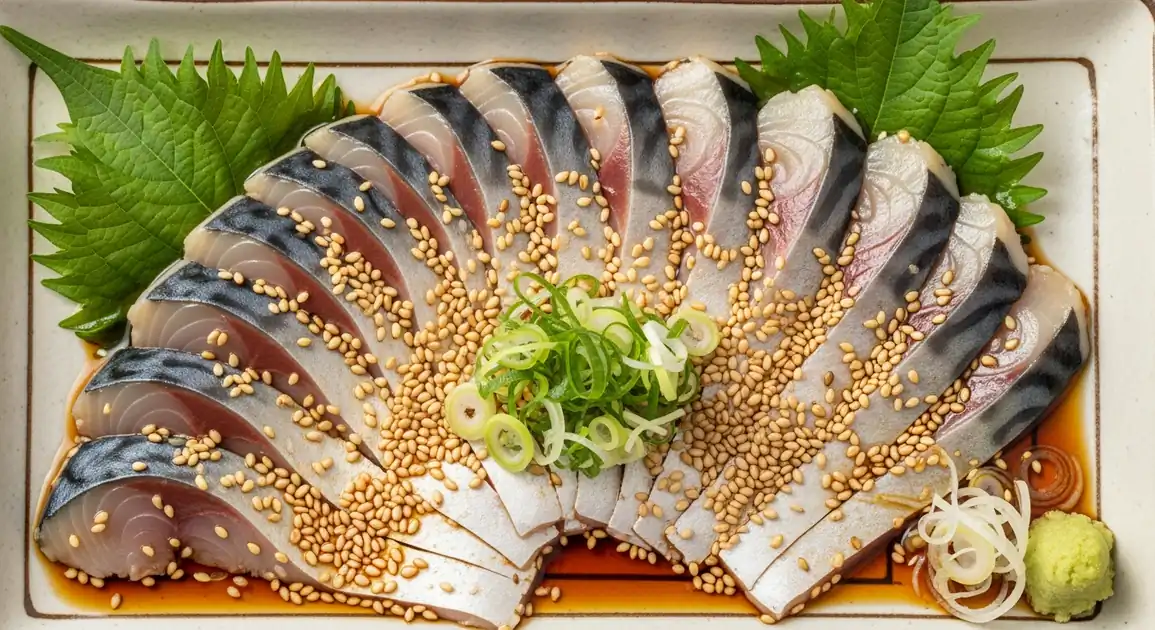Goma Saba (Sesame Mackerel)
ごま鯖 (Goma Saba)

Description
Goma Saba appears throughout Japan but is most closely associated with Kyushu cuisine, where mackerel fishing has deep historical roots. The dish represents Japan's reverence for seasonal, fresh seafood and the minimalist preparation techniques that highlight natural flavors.
Dietary Information
Serving information
Serving style
Traditionally served on rectangular ceramic plates, often with decorative leaves (like shiso) as both garnish and natural antibacterial. Accompanied by condiments like wasabi, grated ginger, and sometimes ponzu sauce for dipping.
Quick facts
Seafood restaurants: 11 AM - 2 PM, 5 PM - 10 PM. Izakayas: 5 PM - 12 AM. Fish markets: Early morning (5 AM - 12 PM).
Safety Tips
What to Look For
-
Establishment specializes in seafood or specifically mackerel dishes
Restaurants with a focus on seafood typically have better sourcing, handling, and preparation techniques for raw fish.
-
Fish is prepared to order or very recently
Due to mackerel's high oil content, it spoils quickly. Fresh preparation is essential for both safety and flavor.
-
Mackerel has clear, bright eyes and firm flesh (if you can see it being prepared)
These are universal indicators of fresh fish. Dull, sunken eyes or mushy flesh indicate older fish not suitable for raw consumption.
-
Thin slices rather than thick chunks
Proper slicing increases surface area exposure to vinegar treatments and makes visual inspection of quality easier.
-
Restaurant is busy with good turnover
High turnover ensures fresh supplies and reduces the time fish spends in storage.
What to avoid
-
Strong fishy smell or ammonia odor
Fresh mackerel should have minimal oceanic aroma. Any strong fishy or chemical smell indicates decomposition has begun.
-
Dull, brownish color or dried edges on the fish
Fresh mackerel slices should be translucent with a clean sheen. Discoloration indicates oxidation and aging.
-
Pre-prepared goma saba sitting in display cases for unknown periods
This dish should ideally be prepared shortly before consumption, not left sitting for extended periods.
-
Restaurants with limited refrigeration or poor temperature control
Proper cold chain maintenance is essential for raw fish safety.
-
Restaurants that seem to have very low customer traffic
Low turnover may mean fish isn't being replaced frequently enough for optimal freshness.
Price information
Price range
Budget tips
- Lunch specials at seafood restaurants often offer goma saba at lower prices (800-1200 JPY) than dinner service.
- Izakayas in non-tourist areas typically offer better value than those in major tourist districts.
- Small portions are sometimes available as part of a teishoku (set meal) for better value than à la carte.
Value indicators
- Freshness is paramount - quality establishments prioritize this over portion size.
- Proper accompaniments (fresh wasabi, high-quality soy sauce) indicate attention to detail.
- Fish should be hand-sliced to order rather than pre-prepared.
- The sesame seeds should be freshly toasted with evident aroma.
Where to Find This Dish
Fish Markets
Many fish markets have attached restaurants or stalls serving ultra-fresh preparations of local catches.
Tsukiji Outer Market (Tokyo), Omicho Market (Kanazawa)
Morning, Early Afternoon
Restaurant Districts
Areas known for traditional Japanese cuisine often have multiple establishments serving quality goma saba.
Pontocho (Kyoto), Dotonbori (Osaka)
Evening
Coastal Cities
Port cities and coastal areas generally offer the freshest mackerel with minimal transportation time.
Hakata Bay area (Fukuoka), Karatsu (Saga Prefecture)
Lunch, Dinner
Vendor Tips
- Ask 'Kyo no saba wa doko kara kimashita ka?' (Where is today's mackerel from?)
- Quality establishments will know and proudly share the source of their fish.
- If concerned about raw consumption, request 'aburi' (lightly seared) version.
How to Order
Regional Variations
-
Aburi Goma Saba
(炙りごま鯖)
A seared version where the surface of the mackerel is lightly torched, creating a partially cooked exterior while maintaining a raw center. This partial cooking reduces bacterial risks while adding a subtle smoky flavor.
-
Shime Saba with Sesame
(しめ鯖のごま和え)
Mackerel that has been cured longer in vinegar (fully 'shime'd) before being topped with sesame seeds, resulting in a firmer texture and tangier flavor than standard goma saba.
-
Goma Saba Don
(ごま鯖丼)
Sesame-coated mackerel served over a bowl of seasoned rice, often with additional toppings like egg, seaweed, or pickled vegetables.
-
Goma Saba with Yuzu Kosho
(柚子胡椒入りごま鯖)
The traditional preparation enhanced with yuzu kosho, a spicy citrus paste that adds heat and brightness to contrast with the rich fish.
-
Katsuo no Tataki Style Goma Saba
(鰹のたたき風ごま鯖)
Inspired by katsuo no tataki, this variation features quickly seared edges while the center remains raw, then is coated with sesame seeds and served with ponzu and ginger.
Cultural context
History
Goma Saba originated in the Kyushu region, particularly around Fukuoka, where fresh mackerel has been historically abundant. The dish represents the Japanese culinary philosophy of highlighting seasonal, local ingredients with minimal intervention. The addition of sesame seeds was a practical enhancement that not only added flavor but helped preserve the highly perishable fish before modern refrigeration. It evolved from simple fishermen's fare to a respected izakaya and restaurant dish throughout Japan.
Local significance
Mackerel holds special importance in Japan as a symbol of abundance and good fortune. Goma saba represents the Japanese culinary philosophy of highlighting natural flavors with minimal intervention.
Eating customs
- Eat promptly after serving for both safety and optimal flavor.
- Appreciate the contrast between the buttery fish and crunchy sesame.
- It's acceptable to add provided condiments to taste, but moderation is key to appreciate the natural flavors.